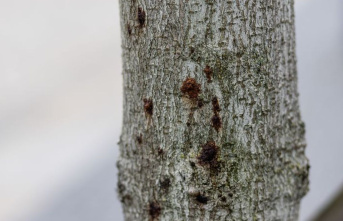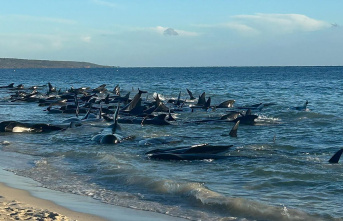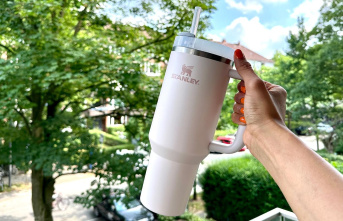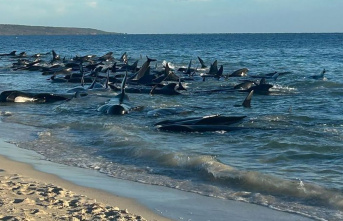After the damage to the Nord Stream gas pipelines under the Baltic Sea, authorities in Germany and Denmark continue to search for the cause. The Danish Navy and German specialists were trying to clarify the situation, the German Press Agency learned from security circles on Tuesday. The cause of the incidents has not yet been clarified. However, there is a lot to be said for sabotage. "In any case, we cannot rule that out," said Danish Prime Minister Mette Frederiksen on Tuesday during a visit to Goleniow near Stettin, Poland, where she attended the inauguration of the Baltic Pipe gas pipeline.
Since the three leaks were discovered some distance apart, it's hard to imagine that it was a coincidence, Frederiksen said. If it is an attack, only a state actor would come into question in view of the technical complexity, it is said. However, it is still too early to draw any conclusions, stressed the Danish head of government.
Poland does not rule out that the leaks in the Nord Stream 1 and 2 gas pipelines discovered by Danish authorities are due to a Russian provocation. The country is in a situation of high international tension, said Poland's Deputy Foreign Minister Marcin Przydacz on Tuesday in Warsaw. "Unfortunately, our eastern neighbor is constantly pursuing an aggressive policy. If it is capable of an aggressive military policy in Ukraine, it is obvious that provocations cannot be ruled out, even in the sections that are in Western Europe."
Russia also does not rule out sabotage or other reasons for the damage. "Now no variant can be ruled out," said Kremlin spokesman Dmitry Peskov on Tuesday when asked whether sabotage could be the reason for the drop in pressure.
On the night of Monday, a sharp drop in pressure was initially detected in one of the two tubes of the unused Nord Stream 2 pipeline. On Monday evening, the operator then also reported a pressure drop in both tubes of Nord Stream 1.
Because of the leaks, the responsible Danish shipping authority has set up restricted zones for shipping near the Danish island of Bornholm. The country's authorities have discovered a total of three leaks in the gas pipelines. The Danish energy authority announced on Tuesday that there was talk of two leaks on Nord Stream 1 northeast of the Baltic Sea island of Bornholm and one on Nord Stream 2 southeast of the island. In the case of Nord Stream 1, one leak is in Danish waters and the other in Swedish waters. The Nord Stream 2 leak is in Danish waters.
Investigations are currently being carried out, said a spokesman for Nord Stream AG, which is responsible for Nord Stream 1. No information can be given beforehand on the extent of any damage. In the area around Bornholm, the lines are about 70 meters below the water surface, he says. According to Nord Stream 2 spokesman Ulrich Lissek, the lines are laid in such a way that it is highly unlikely that several lines will be damaged at the same time, for example by a single ship accident. When asked whether he was aware of similar incidents in connection with offshore pipelines, he said: "I've never heard of them."
In an interview with the German Press Agency, an expert for underwater robots also referred to the extremely high safety standards and the very robust construction of the lines. From his point of view, only deliberate manipulation is possible. An unnamed insider, to whom "Spiegel" refers, sees it similarly. Three out of four strands of the Baltic Sea pipelines were damaged, one does not believe in a coincidence. With diving robots, investigations are now to be carried out on the pipelines, and the safety concepts of other pipelines and gas supply systems are being checked at high pressure, according to "Spiegel".
As the Danish newspaper "Jyllands-Posten" reported, citing the Danish military, the leak at Nord Stream 2 was discovered by Danish F-16 fighter jets on Monday. They were therefore sent into the air from Bornholm to photograph the area. They had discovered that at a point south-east of the island bubbles had risen from the water.
According to the Danish Energy Agency, ships' propulsion could fail if they enter the area where the gas is rising. There is also a risk of ignition. There is no danger outside the zone, not even for the residents of Bornholm and the small neighboring island of Christiansø.
German and Danish authorities pointed out that the incidents had no impact on the gas supply, as the pipelines had not recently been used for gas imports. According to the Stralsund Mining Authority, which is responsible for technical safety, consequential damage is also unlikely; the risk is low. "A further spread of damage should be unlikely from a technical point of view - according to the current status," said the authority on Tuesday. The pressure in the lines was set to a low level in accordance with the water depth. "
The Bund für Umwelt und Naturschutz (Bund) estimates the potential short-term impact of the leaks on the Nord Stream 1 and 2 gas pipelines on the environment as locally limited.
While gas was still flowing from Russia to Germany via the Nord Stream 1 pipeline until a few weeks ago - albeit with reduced capacity - the German government put the permit for import via Nord Stream 2 on hold shortly before the Russian attack on Ukraine been. After that, she had ruled out use because of the war.












